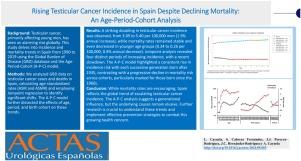Rising testicular cancer incidence in Spain despite declining mortality: an age-period-cohort analysis
引用次数: 0
Abstract
Background
Testicular cancer, primarily affecting young men, has seen an alarming rise globally. This study delves into incidence and mortality trends in Spain from 1990 to 2019 using the Global Burden of Disease (GBD) database and the Age-Period-Cohort (A-P-C) model.
Methods
We analyzed GBD data on testicular cancer cases and deaths in Spain, calculating age-standardized rates (ASIR and ASMR) and employing Joinpoint regression to identify significant shifts. The A-P-C model further dissected the effects of age, period, and birth cohort on these trends.
Results
A striking doubling in testicular cancer incidence was observed, from 3.09 to 5.40 per 100,000 men (1.9% annual increase), while mortality rates remained stable and even decreased in younger age groups (0.34 to 0.26 per 100,000, 0.8% annual decrease). Joinpoint analysis revealed four distinct periods of increasing incidence, with a recent slowdown. The A-P-C model highlighted a consistent rise in incidence risk with each successive generation born after 1935, contrasting with a progressive decline in mortality risk across cohorts, particularly marked for those born since the 1960s.
Conclusion
While mortality rates are encouraging, Spain reflects the global trend of escalating testicular cancer incidence. The A-P-C analysis suggests a generational influence, but the underlying causes remain elusive. Further research is crucial to understand these trends and implement effective prevention strategies to combat this growing health concern.

西班牙睾丸癌发病率上升而死亡率下降:年龄-时期-队列分析》。
背景:睾丸癌主要影响年轻男性,其发病率在全球范围内呈惊人上升趋势。本研究利用全球疾病负担(GBD)数据库和年龄-时期-队列(A-P-C)模型,深入研究了1990年至2019年西班牙的发病率和死亡率趋势:我们分析了西班牙睾丸癌病例和死亡的 GBD 数据,计算了年龄标准化比率(ASIR 和 ASMR),并采用 Joinpoint 回归法确定了显著的变化。A-P-C模型进一步剖析了年龄、时期和出生队列对这些趋势的影响:结果:观察到睾丸癌发病率翻了一番,从每 10 万名男性中 3.09 例增加到 5.40 例(年增长率为 1.9%),而死亡率保持稳定,年轻年龄组的死亡率甚至有所下降(每 10 万名男性中 0.34 例下降到 0.26 例,年下降率为 0.8%)。结合点分析显示,发病率有四个不同的上升期,最近有所放缓。A-P-C模型突出表明,1935年后出生的每一代人的发病风险都在持续上升,与此形成鲜明对比的是,各年龄组的死亡率风险在逐步下降,这在20世纪60年代后出生的人群中尤为明显:结论:西班牙的死亡率令人鼓舞,但也反映了全球睾丸癌发病率不断上升的趋势。A-P-C分析表明,睾丸癌的发病率与世代因素有关,但其根本原因仍难以捉摸。要了解这些趋势并实施有效的预防策略来应对这一日益严重的健康问题,进一步的研究至关重要。
本文章由计算机程序翻译,如有差异,请以英文原文为准。
求助全文
约1分钟内获得全文
求助全文

 求助内容:
求助内容: 应助结果提醒方式:
应助结果提醒方式:


